Contents
Strawberries are one of the most popular garden crops. This sweet berry is grown in many countries, it is selected and constantly improved. To date, several thousand varieties of garden strawberries and wild strawberries have been bred, some of them are sweeter and more fragrant, others can be stored for a long time, the third are not afraid of the cold, and the fourth bear fruit all year round (remontant varieties). Unfortunately, these strawberry varieties have not only strengths, plants are also susceptible to many diseases.

You can learn about strawberry diseases with photos and methods of their treatment from this article.
What causes garden strawberries
Most of all, strawberries are prone to fungal diseases. This situation is especially aggravated during the rainy period, when the air temperature drops, in cloudy, sunny weather. The fungus can appear not only on the greens of strawberry bushes, it affects both the roots and the berries themselves.

The most famous and frequent diseases of garden strawberries are:
- rot: white, gray, black, root and late blight;
- powdery mildew;
- fusarium wilt of bushes;
- spotting: white, brown and black.
A detailed description of these strawberry diseases with a photo, as well as methods for dealing with ailments, can be found below.
White rot strawberries
Strawberry white rot occurs due to a lack of heat and light, as well as in conditions of high humidity. You can find out about the infection of the bushes by the extensive whitish spots that appear on the strawberry leaves – this is rot.
Later, spots from strawberry leaves move to its fruits – the berries become white, covered with a fungus. Such strawberries are unsuitable for human consumption.

Means for the prevention of white rot are:
- planting strawberry bushes in a place well-lit by the sun, located on a hill;
- acquisition and planting of healthy, uninfected seedlings;
- maintaining sufficient distances between the bushes in the rows;
- timely removal of weeds that create additional shade and thicken plantings.
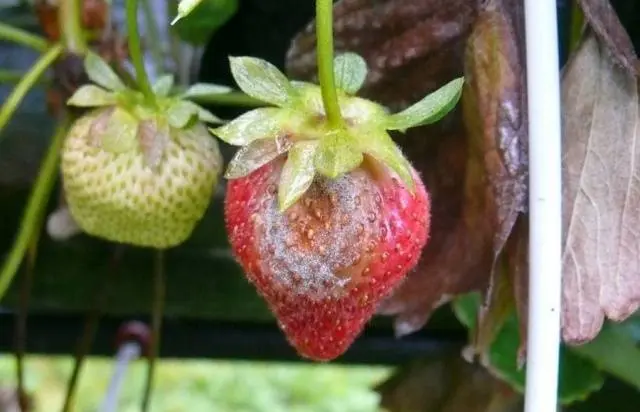
If it was not possible to protect strawberries from this disease, you can try to fight rot: infected bushes must be treated with fungicidal preparations, for example, use Svitich or Horus.
gray strawberry rot
The most common diseases of remontant strawberries and ordinary garden berries are associated with the appearance of gray rot. This is not surprising, because the appearance of this disease is facilitated by a warm and humid microclimate: this is the weather that reigns in greenhouses and is often observed in summer throughout most of the country.
If we add to the weather factors the fact that strawberries have been grown in one place for a long time, we can talk about gray rot infection of up to 60% of the bushes.
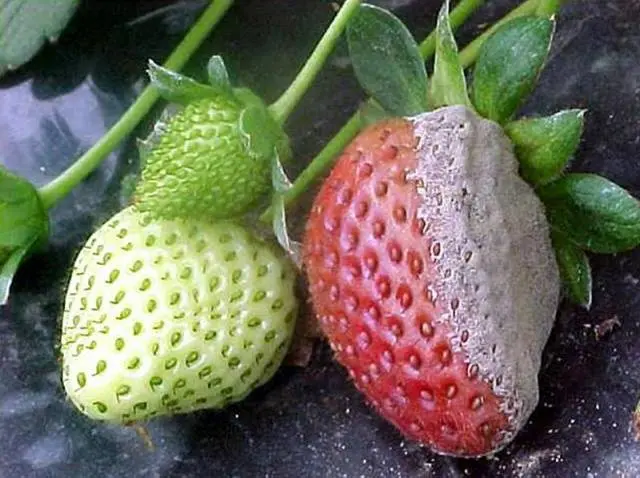
You can recognize the disease by the following signs:
- hard brown spots appear on the fruits of garden strawberries, subsequently covered with a gray coating;
- affected strawberries shrivel and dry out;
- brown and gray spots of rot gradually pass to the leaves of strawberry bushes.
Fungal diseases of strawberries and the fight against them come down to preventive measures, such as:
- Regular weeding and weed removal.
- Sprinkling the earth with ash or lime.
- During flowering or immediately before it, treat the strawberry bushes with Bordeaux liquid or a Barrier type product.
- In autumn, after harvesting, you need to wait for the beginnings of new leaves to appear and remove all old foliage.
- A good means of preventing the disease is the alternation of strawberry rows with onions or garlic.
- Mulching beds with straw or pine needles.
- Removal of diseased flowers, leaves and berries.
- Regular and frequent harvest.

It must be remembered that strawberry varieties are less susceptible to various diseases, in which the flower stalks are located above the petioles of the leaves, that is, when the bush and berries do not touch the ground.
black root rot
Another disease of strawberry bushes is root rot. It first appears on young roots, looks like black spots that gradually grow and merge.
Then the whole bush from the roots to the outlet becomes brown, the roots will be fragile and brittle, lifeless. As a result, the yield drops sharply, because there is no “living place” left on the strawberries, the entire bush becomes infected.

Root rot can begin at any stage of the strawberry growing season and lasts until the death of the bush or until the onset of frost.
Treating root rot is difficult, or rather impossible. Damaged bushes must be dug up along with the roots and burned, and the ground must be treated with disinfectants.

Ways to prevent the disease are as follows:
- Feed strawberries only with rotted compost, as pathogenic bacteria and viruses remain in unripe fertilizer.
- As soon as the snow melts, the bushes need to be treated with a fungicide.
- Before covering strawberries for the winter, they should also be treated, for example, with Phytodoctor.
- Choose only well-lit, dry areas of the garden for planting garden strawberries.
Black fruit rot
Another disease of garden strawberries is black rot. The appearance of such an infection contributes to hot and humid weather. It is considered characteristic of this disease that rot spots appear only on the berries, the bushes themselves remain healthy.

At first, the strawberries become watery, lose their natural color, acquire a brown tint. Berries do not have a characteristic strawberry aroma and taste. Subsequently, the fruit is covered with a colorless coating, which after a while becomes black.
Strawberry diseases which are associated with fungal infections are very difficult to treat. You cannot cure a bush from black rot, you can only pluck the affected berries and burn them.
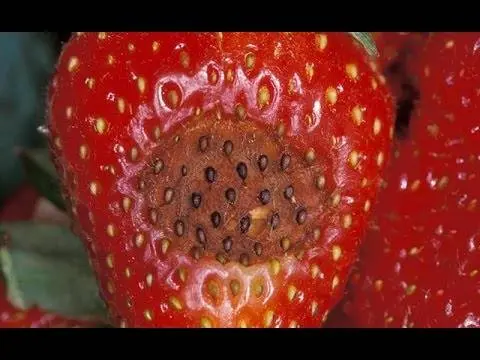
To prevent the disease, the following recommendations must be followed:
- plant strawberry seedlings on high beds (hill of the earth 15-40 cm high);
- dissolve two grams of potassium permanganate in a bucket of water and pour bushes with this solution – this will disinfect the soil and improve the quality of the fruit;
- use less nitrogen-containing and organic top dressing.
Phytophthora rot
The most dangerous fungal disease of strawberries is late blight rot. From this disease, the entire crop, to the last bush, can die very quickly.
Late blight affects the entire bush, but its first signs appear on strawberries. First, the skin of the berries thickens, the flesh becomes hard, has a bitter taste, then dark purple spots appear on the strawberries and the fruits dry out.

Then all the leaves dry and even the stem of the strawberry bush. The cause of late blight may be improper watering, because, like other fungal infections, this one appears against the background of high humidity.
Late blight remains in the soil for a long time, it does not disappear from infected bushes either, so it is important to follow agricultural practices and cultivate the land and the seedlings themselves.

You can protect young strawberries from late blight rot like this:
- Together with the harvest, collect diseased berries, dry foliage, extra mustache – thin out the bushes as much as possible.
- Do not overfeed strawberries.
- Treat plants before shelter for the winter.
- Plant only those varieties that are immune to late blight rot.
- Between plantings of different varieties of strawberries, observe an interval of at least two meters.
- For normal ventilation and lighting, follow the planting pattern of 30×25 cm.
Mučnistaâ rosa
This strawberry disease also applies to fungal infections. The disease damages both leaves and fruits, so it can significantly reduce the yield or even completely destroy it.

Description of symptoms of powdery mildew with a photo:
- on the wrong side of the leaves, individual whitish spots begin to appear, which look like plaque;
- gradually the spots grow and merge into a single whole;
- leaves curl, wrinkle, become thicker;
- the growth of the ovaries stops, they turn brown and die;
- on those berries that have already formed, a white coating appears, gradually the fruits turn blue and rot;
- even the whiskers of strawberries die off, turning brown.
If the air temperature is high and the humidity is high, powdery mildew will develop very rapidly.
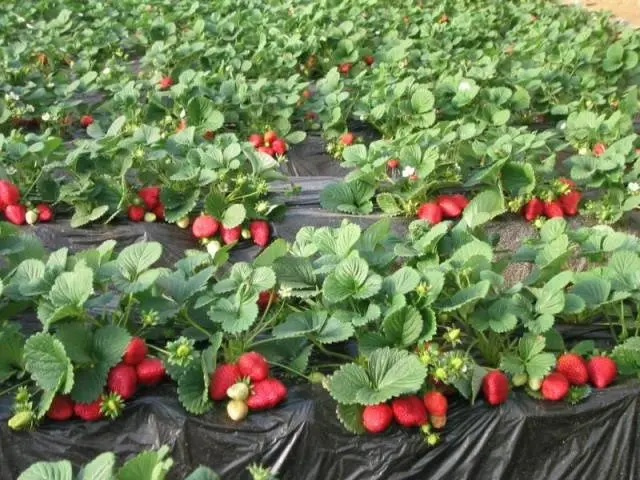
The following will help prevent the disease:
- before planting strawberry seedlings, its roots are treated with copper sulphate;
- before the strawberries begin to bloom, they should be treated with Topaz;
- strawberry leaves should be sprayed with complex mineral fertilizer.
When the bushes are already infected, you can try to fight the disease. Powdery mildew is treated like this:
- Last year’s foliage from infected bushes must be collected and burned.
- The bushes that were sick last season should be sprayed with a solution of soda ash for the next year.
- When the berries begin to fill and sing, they should be treated with cow’s serum diluted in water (1:10).
- If the situation worsens, you can add a few drops of iodine to the serum. Process every three days.
Fuzarioz
Fusarium wilt is a disease characteristic of many garden and horticultural crops. One of the reasons for the appearance of the infection is called intense heat, as well as an excess of weeds in the area.
It is easy to understand that strawberries have become ill with Fusarium: the bushes turn brown and dry out quickly. All parts of the plant disappear: stems, leaves, berries and even roots.

It is difficult to treat Fusarium wilt, it is possible only in the very early stages of the disease. In such cases, use any fungicidal preparation.
It is much easier to prevent the disease:
- Choose only healthy seedlings for planting.
- Do not plant strawberries where potatoes grew.
- Do not plant bushes again in the same place earlier than four years later.
- Remove weeds promptly.
White spot
A common leaf disease of garden strawberries is white spot. Oddly enough, the first signs are not white spots, but small round dots of a reddish-brown hue that appear on the entire leaf area.
Gradually, the spots merge into a large spot, the middle of which brightens, and eventually perforates – the sheet becomes perforated. As a result of the activity of this fungus, up to half of the green mass of bushes is lost, which leads to a significant decrease in yield and a deterioration in the taste of strawberries.

It will not work to treat white spot, the bushes will have to be removed. Healthy strawberries without signs of disease must be treated with antifungal drugs, which contain copper.
Manifestations of spotting are very dangerous. How to deal with them:
- after harvesting, feed strawberries with phosphorus-potassium compounds that increase plant immunity;
- control the amount of nitrogen and organic fertilizers;
- observe the recommended distance between the bushes;
- change mulch every spring and remove dry leaves;
- process strawberries with a Bordeaux mixture three times a season.
Brown spot of garden strawberry
The characteristic of this disease suggests that brown spotting is very dangerous, and most importantly, it is insidious, since the course of the disease is sluggish, mild. As a result, more than half of the strawberry bushes may die.
The disease begins to progress, as a rule, in the spring – in April. Brown spots of small size first appear on the edges of the leaves, then merge and cover a large area of the leaf plate.
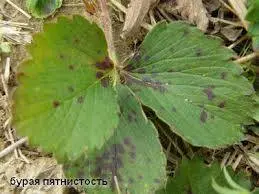
On the outer side of the leaves, over time, you can see black spores that have germinated through the plate. Inflorescences, ovaries and mustaches of strawberries are covered with blurry crimson spots.
In the middle of summer, strawberries begin to rejuvenate, new leaves appear, and at first it may seem that the spotting has receded. But this is not so, the disease will soon return with renewed vigor.
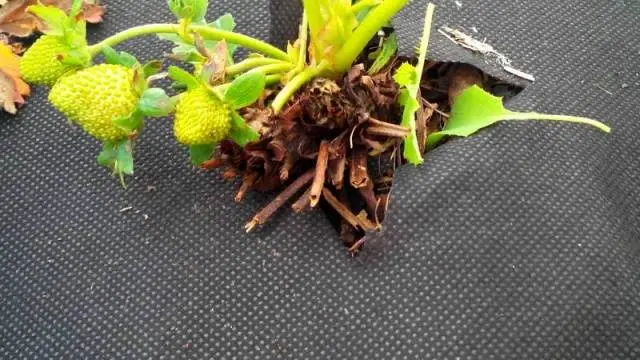
You need to deal with brown spotting like this:
- In early spring and late autumn, remove all diseased and dry leaves.
- Mulch the ground, do not allow it to become waterlogged.
- Remove pests, as they can carry spores of the infection (the most dangerous pest of strawberries is the spider mite).
- Feed strawberries with phosphorus and potassium to increase immunity, but it is better not to get carried away with nitrogen.
- After the crop is harvested, the bushes can be treated with Fitosporin.
Anthracnose strawberry
This disease is also called black spot, its causative agent is a fungus that affects the entire plant as a whole.
The disease develops in rainy weather in spring or June, when the air temperature is already quite high. Fungus spores can enter the garden through seedlings, soil, with a tool or on the soles of shoes.

First, red leaves appear on strawberries, then they crack and dry. Stems and shoots are covered with ulcers with a light center and dark edges. As a result, the stem dies off, and the bush dries up.

When strawberries are red, the fungus shows up as watery spots that darken later. There are no such fruits! Still unripe berries can become covered with depressed dark spots – the fungus hibernates here.
Fighting anthracnose is difficult. In the first few days after infection, you can try fungicide treatment, later the bushes are treated with a Bordeaux mixture. Strawberries should be treated with the same preparation for prevention, they do this three times a season, adding sulfur to the solution.
Conclusions

Only the most common strawberry diseases and their treatment are presented here. In fact, a garden berry can get sick with at least a dozen more infections. In addition, various pests “love” strawberries, such as slugs, ants, May beetle larvae, spider mites and other insects. It is they who carry the spores of the fungus most often, so the gardener should regularly inspect the bushes for pests and treat the plants with suitable insecticides.









